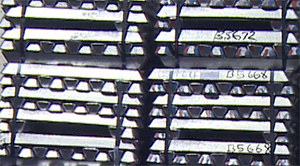LM24 Castings
LM24
Aluminium Casting Alloy (AL – Si8Cu3Fe)
Colour Code – Red/Blue
Chemical composition
Copper 3.0 – 4.0
Magnesium 0.3 Max
Silicon 7.5 – 9.5
Iron 1.3 Max
Manganese 0.5 Max
Nickel 0.5 Max
Zinc 3.0 Max
Lead 0.2 Max
Tin 0.2 Max
Titanium 0.2 Max
Aluminium Remainder
Mechanical Properties
|
|
Chill Cast |
Die Cast |
|
|
|
|
|
0.2 % Proof Stress ( N/mm2)* |
100 – 120 |
150 |
|
Tensile Stress ( N/mm2)* |
180 – 220 |
320 |
|
Elongation ( % )* |
1.5 - 4 |
1 – 3 |
|
Impact Resistance. Charpy (Nm) |
- |
3.4 |
|
Brinell Hardness Number |
85 |
85 |
|
Modulus of Elasticity (x103 N/mm2) |
71 |
71 |
The values shown are typical for chill cast bars produced to the requirements of BS 1490 or diecast 6mm diameter test bars; minimum specification requirements are in heavy type. Charpy test is for an un-notched test bar.
Strength at Elevated Temperatures
Room temperature tensile strength is largely maintained up to temperatures of the order of 150°C, and approximately halved at 250°C. It should be noted, however, that other factors may restrict the use of diecastings at elevated temperatures.
Physical Properties
Coefficient of thermal Expansion (per degree Centigrade at 20 – 30°C.) 0.0000021
Thermal Conductivity ( Cal / cm2 / cm / °C / sec at 20°C) 0.23
Electrical Conductivity ( % Copper Standard at 20°C) 24
Specific Gravity 2.79
Freezing Range ( °C ) approx. 520 – 580
Figure for conductivity applies to diecastings. Values are approximate and will vary with condition.
Machinability
Machining practice is similar to that for other Aluminium casting alloys containing silicon. Whilst there is not the tendency to drag associated with high silicon alloys such as LM6, tool wear is more rapid than in the case of alloys containing relatively small amounts of silicon. The use of carbide-tipped tools is recommended but a good finish can be obtained with high speed steels. Lower alloy steel tools may be used provided they are frequently re-ground to maintain a sharp cutting edge. A cutting lubricant and coolant should be employed.
Corrosion Resistance
Resistance to attack under normal atmospheric conditions is similar to that of alloy LM4 – fairly good. In marine atmospheres, or under other severe conditions, castings in this alloy should be protected by painting.
Anodising
Anodising treatment by either the chromic or sulphuric acid process produces an anodic film of a grey colour. The surfaces of diecastings, however, are not generally suitable for decorative anodising.
Casting Characteristics
FLUIDITY – Although slightly less fluid than LM6 and LM2, the alloy is used successfully for castings of thin sections.
PRESSURE TIGHTNESS – Suitable for leak-tight castings.
HOT-TEARING – Most castings may be produced in this alloy with complete absence of hot-tears.
TYPICAL POURING TEMPERATURE – Pouring temperatures for diecastings depend very largely on the particular casting and the machine, and vary too widely for a typical temperature to provide useful guidance. The melt should not, however, be allowed to stand at temperatures only little above the freezing range or the bottom of the melt may become enriched in such elements as iron and manganese.
Heat Treatment
Castings in this alloy are not heat-treated.
Applications and General Notes
LM24 is essentially a die casting alloy. It has excellent casting characteristics and is generally a little simpler to diecast than the higher silicon-containing alloys. Diecastings in LM24 are suitable for most engineering applications and have an advantage over an alloy such as LM6 when maximum mechanical properties are required. In practice LM6 is preferred to LM24 only for diecastings in which a high resistance to corrosion is the primary requirement.
For the vast majority of diecastings, the alloys LM2 and LM24 are equally suitable.

Why choose Kemlows?
- We provide 100% satisfaction at world competitive prices

- You get our knowledge and wealth of experience for free

- We only promise that which we can
deliver











